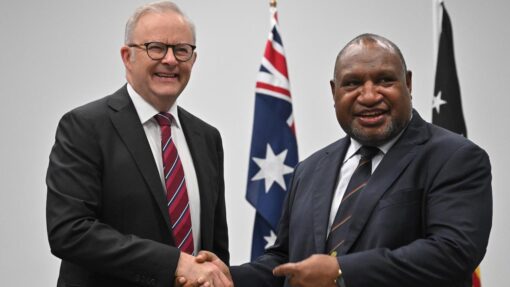Van from Snowy River gets better with age
Peter Atkinson |

In the Australian motoring landscape it’s almost akin to the election of a new Pope – a mixture of rarity and reverence. Without the white smoke.
For a few million or so rusted-on devotees, the release of an all-new Toyota LandCruiser is treated every bit as religiously as a papal vote, so infrequently does it occur.
Toyota’s legendary four-wheel drive first arrived Down Under in the 1950s, when, because of its off-road capabilities, it was seconded to work on the Snowy River hydro-electric scheme.
The Van from Snowy River. No wonder it’s made such a connection with so many Australians. And why cashed-up Aussie buyers are literally lining up to lay down their money for this all-new LandCruiser 300 Series – the first such all-new model for almost 15 years.
The wait for delivery, as things stand, is somewhere between six and nine months, which would explain why there’s been so much heard about this new model, which is actually rarely seen.
Spare a thought for Japanese buyers who are facing a four-year delay between order and delivery of a shiny new ‘Cruiser.
This all-new 300 Series is a rebuild from the ground up and the first to benefit from Toyota’s new Global Architecture platform. Although park the old and new models side by side and the differences could be described as marginal.
To the surprise of virtually no-one, it’s not a world away from the model it replaces, at least in appearance. ‘If it ain’t broke,’ and all that. And everybody knows LandCruisers are seemingly unbreakable.
It’s quite a bit smoother and quieter, and feels more nimble to drive than its predecessors. Not that its 2.5-tonne weight ever ceases to make its presence felt.
But more than any model to previously wear the fabled LandCruiser badge, this one feels noticeably more civilised.
That’s partly because the all-new platform is more car-like, further accentuated by the arrival of a new heartbeat – a 3.3-litre twin-turbocharged V6 diesel which is world class, delivering better output than the superseded V8, yet using much less fuel.
That new engine is mounted to a segment-leading 10-speed automatic transmission, with half-a-dozen off-road settings and impressive new suspension set up, further refining and improving its road manners.
Style-wise it’s … well … in keeping with the model’s tradition.
There are some notable new design cues. For instance the massive scoop down the centre of the bonnet, which is deep and wide enough to be used as a kids water-slide.
Tested here is the second-most affordable model in the new LC300 fleet, the long-serving GXL model. If affordable is the word.
Even the most modest LandCruiser these days is an expensive thing – the base model GX sells for $89,990 while the GXL tips marginally over $100,000.
The revered flagship Sahara ZX costs a not inconsiderable $138,790 (plus on-road fees which will push the spend dangerously close to $150,000).
For the first time there’s a co-flagship sharing the coveted Sahara badge – the off-road focused Sahara GR Sport. Costing $1000 less than the ultimate ZX, it features go-anywhere capability thanks to something called an electronic Kinetic Dynamic Suspension.
The 300 Series the most expensive Cruiser ever, and by some margin.
And that’s before any accessories are fitted. The GXL test machine had a factory-fitted bullbar on the front – helpful for the hard-core offroaders who’ll buy this diesel-powered model, but probably detracting from the quite handsome, chromy front-end treatment in the standard model. At least it provides somewhere to hang a towel when leaving the surf.
The new diesel, which delivers a beefy yet smooth and sharp 227kW and 700Nm, is impressive.
More than ever, it’s a relaxed and refined highway cruiser whose long legs and massive, 100-litre fuel tank make it capable and enticing enough to drive all day. The test car covered 200km before the fuel gauge moved from ‘full’.
The 300 Series gets a full selection of off-road settings including dirt, sand, mud, deep snow, rock and a clever, self-adjusting Auto mode. All but one offer low range.
There’s a generous suite of electronic driver aids including active cruise control, predictive curve speed reduction, traffic sign recognition and an aggressive lane departure system that will grab the wheel and even brake if it senses the need.
Top-spec models even get an under-floor camera to ensure sufficient clearance when paddling through the soft stuff of down rutted tracks. Clever.
Interestingly, Toyota has surrendered one of the major selling points of previous models – cutting capacity from the customary eight seats down to seven, in what might be a controversial move.
Still, it’s massively roomy, nicely finished and, mostly generously appointed.
The cockpit speaks of quality, if not minimalism. There’s a centre stack with enough buttons to launch a space shuttle and which, at least until familiar with the Cruiser, can be a bit confusing with smallish print or confusing icons.
One particular peeve – this bush-bashing, highway-cruising, long-distance-travelling machine will go just about anywhere – but don’t expect to rely on satellite navigation to get home. There isn’t any on the GLX tested here, which seems stingy for a car costing $100,000.
Yes, it’s big, flexible, capable and, to its loyal army of rusted-on fans and followers, absolutely perfect.
But with a price tag approaching $150-grand it inevitably invites comparison with some of the very fancy, very up-market full-sized SUVs being offered by European competitors (think BMW X7, Mercedes GLS and Audi Q8).
Truth is, despite the fact they arrive at roughly similar price points, the Sahara and the Europeans appeal to vastly different markets.
The Toyota is a luxurious, somewhat refined version of a legendary off-roader that will go just about anywhere in style and comfort.
The German trio, on the other hand, take the size and practicality of an SUV to the boulevards and corporate car parks of the upper class.
So the buyer profile is vastly different.
And for that reason, traditional LandCruiser buyers will still admire and aspire to owning the Sahara, and will be more than happy with the improvements and developments of this latest model.
Who knows, the Pope might even be seen cruising around in the back of one some time.
* HOW BIG? Fair to say it’s as big as ever (in fact, even roomier inside) – even though it now has seven seats instead of eight.
* HOW FAST? Nearly three tonnes takes some time to wind up – not really a strong suit – although the new engine and auto are first class.
* HOW THIRSTY? Somehow thirst has been trimmed to 8.9L/100km, which is excellent.
* HOW MUCH? Prices start at $89,990 (plus on road costs) for the base model, rising all the way up to $138,790 for the flagship Sahara ZX.
AAP


